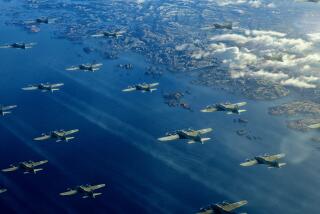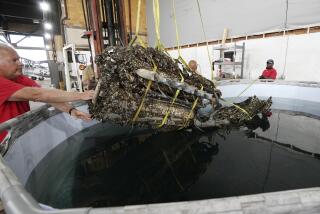The Old Aircraft of Richard Shuttleworth: It’s Quite a Collection
- Share via
BIGGLESWADE, England — A Spitfire, the most famous fighter aircraft of World War II, zooms low over the Bedfordshire countryside.
For a schoolboy watching, pages from his history books come to life; for his father, dim memories of that war, and for a grandfather, vivid recollections of the summer in 1940 when the Royal Air Force created a legend in the skies over southern England.
After entertaining the crowd for several more minutes, the plane comes in to land on the grass airstrip and taxis across to the flight line to join other historic airplanes of the Shuttleworth Collection at Old Warden Aerodrome, near Biggleswade, about 50 miles north of London.
Old Warden has no concrete runways, just a windsock, a small control tower and old-fashioned hangers, all helping to conjure an image of goggles, leather flying jackets and the days when flying was an adventure rather than a ride in a pressurized tube.
Those days of the ‘30s, ‘20s and earlier are brought vividly to life when aircraft from those eras take to the air on summer evenings and weekends.
Autos to Airplanes
The Shuttleworth Collection was announced in 1947, but it started earlier when Richard Shuttleworth obtained a 30-year-old Panhard Levassor car that had been driven to Ascot races by King Edward VII. That began his interest in collecting, first cars and carriages, then early airplanes.
He learned to fly and bought a De Havilland Gypsy Moth in 1930. But the collection really got started in 1934, when he was offered a 1909 Bleriot monoplane and a semi-wrecked 1910 Deperdussin by a garage owner.
Shuttleworth was not interested in a collection of museum pieces, his aim being to restore every specimen so it would work as well as when it had been new.
By the start of World War II he had collected more than a dozen aircraft, all of which were stored for the duration of the war. Shuttleworth joined the Royal Air Force and was killed in a flying accident in 1940.
A rich man with no direct heirs, he left about 1 million to his mother. At the end of the war she endowed a trust to maintain and expand the collection as a memorial to her son.
Friends Carry On
A friend of his, who had helped to recover the Bleriot, was appointed aviation trustee. He was Air Commodore Allen Wheeler, who was joined at Old Warden by another of Shuttleworth’s friends from the ‘30s, Squadron Leader L. A. Jackson, a man with wide technical knowledge and skills.
So in 1947 the Shuttleworth Collection came into being, with the Bleriot and Deperdussin flying again. Since then the expansion of the collection has continued, and is still doing so with the restoration of the De Havilland Comet, which won the England-to-Australia Air Race in 1934.
The Comet last flew in 1938 and spent the war years in the open, after which it was put on display during the Festival of Britain. It was handed over to the collection in 1965, and the work of restoring it to flying condition began with help donated by many companies in the aerospace industry. It is hoped that the airplane will soon fly again.
Five WWI Aircraft
The collection has 34 aircraft, about half of them the sole surviving examples of their type. World War I is represented by five aircraft, including a 1916 Bristol Fighter and a S.E.5A, which was the plane of one of Britain’s top aces, Capt. Albert Ball, VC.
From the opposing side there is a German L.V.G. cV1, a light reconnaissance and bomber aircraft. It was built at the end of World War I by the RAF from parts cannibalized from captured aircraft, to compare with its British rival the Bristol Fighter. During the ‘30s these planes performed mock dogfights at air pageants. It was bought by the collection in 1966, and after restoration, continued the mock battles with the Bristol Fighter.
In restoring this aircraft, Shuttleworth engineers studied closely the only other remaining specimen of the plane, which hangs in a museum in Belgium.
Game of Detection
One of the major problems in restoring old aircraft is that in many cases no plans are available--many evolved on the workshop floor--so restoration becomes a detective game using museum exhibits, old photographs and the fading memories of aviation pioneers.
The period between the world wars contains a mixture of planes representing developments in civil and military flying. Among these are a Hawker Hind light bomber that was retrieved on a 6,000-mile overland journey from Afghanistan.
Also in this group is the last of the RAF’s biplane fighters, the 1937 Gloster Gladiator. Three of this type of aircraft, called Faith, Hope and Charity, provided the only air defenses for the island of Malta in World War II. They put up a spirited resistance before being downed by overwhelming numbers.
Apart from a week during the Christmas season, the collection is open daily from 10:30 a.m. to 5:30 p.m. As well as the historic aircraft, the collection of vintage vehicles and motorcycles can be examined at close quarters in the hangers. There is a restaurant, snack bar and gift shop.
Flying displays are held on two evenings in June and July. The timing is in the hope that the wind will have dropped and the earliest planes can be flown.
For the Bleriot and Deperdussin, flying means hops of a few hundred feet along the length of the runway, but the others take to the air, including two reproductions specially built for the film “Those Magnificent Men in their Flying Machines.” These are a 1910 Avro Triplane and a Bristol Boxkite, the only two machines in the collection that are not truly original.
Apart from these evening flying displays, from April to October on the last Sunday of the month there are flying days. Aircraft taking part are not only those from the collection but also from other museums and private owners and military aircraft.
These Sundays are family affairs, with many spectators arriving early for a picnic lunch on the grass, then a leisurely look around at the static displays in the hangers or on the flight line, before settling down to watch the flying display.
Certainly the collection is a magnet to anyone with an interest in flying, as was well illustrated when astronaut Neil Armstrong visited Britain in 1971 after his epic moonwalk. Where did he ask to be taken? The Shuttleworth Collection, of course.
For further information, contact the British Tourist Authority, 350 S. Figueroa St., Los Angeles 90071; phone (213) 628-3525.
More to Read
Sign up for Essential California
The most important California stories and recommendations in your inbox every morning.
You may occasionally receive promotional content from the Los Angeles Times.










